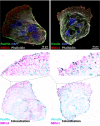The electroneutral Na+-HCO3- cotransporter NBCn1 (SLC4A7) modulates colonic enterocyte pHi, proliferation, and migration
- PMID: 38646790
- PMCID: PMC11371319
- DOI: 10.1152/ajpcell.00079.2024
The electroneutral Na+-HCO3- cotransporter NBCn1 (SLC4A7) modulates colonic enterocyte pHi, proliferation, and migration
Abstract
NBCn1 (SLC4A7) is one of the two major Na+-HCO3- cotransporters in the human colonic epithelium, expressed predominantly in the highly proliferating colonocytes at the cryptal base. Increased NBCn1 expression levels are reported in tumors, including colorectal cancer. The study explores its importance for maintenance of the intracellular pH (pHi), as well as the proliferative, adhesive, and migratory behavior of the self-differentiating Caco2BBe colonic tumor cell line. In the self-differentiating Caco2BBe cells, NBCn1 mRNA was highly expressed from the proliferative stage until full differentiation. The downregulation of NBCn1 expression by RNA interference affected proliferation and differentiation and decreased intracellular pH (pHi) of the cells in correlation with the degree of knockdown. In addition, a disturbed cell adhesion and reduced migratory speed were associated with NBCn1 knockdown. Murine colonic Nbcn1-/- enteroids also displayed reduced proliferative activity. In the migrating Caco2BBe cells, NBCn1 was found at the leading edge and in colocalization with the focal adhesion markers vinculin and paxillin, which suggests that NBCn1 is involved in the establishment of cell-matrix adhesion. Our data highlight the physiological significance of NBCn1 in modulating epithelial pH homeostasis and cell-matrix interactions in the proliferative region of the colonic epithelium and unravel the molecular mechanism behind pathological overexpression of this transporter in human colorectal cancers.NEW & NOTEWORTHY The transporter NBCn1 plays a central role in maintaining homeostasis within Caco2BBe colonic epithelial cells through its regulation of intracellular pH, matrix adhesion, migration, and proliferation. These observations yield valuable insights into the molecular mechanism of the aberrant upregulation of this transporter in human colorectal cancers.
Keywords: acid/base balance; cell migration; colon cancer; pHi regulation; sodium bicarbonate cotransporter.
Conflict of interest statement
No conflicts of interest, financial or otherwise, are declared by the authors.
Figures









Similar articles
-
The electroneutral Na⁺:HCO₃⁻ cotransporter NBCn1 is a major pHi regulator in murine duodenum.J Physiol. 2012 Jul 15;590(14):3317-33. doi: 10.1113/jphysiol.2011.226506. Epub 2012 May 14. J Physiol. 2012. PMID: 22586225 Free PMC article.
-
Na+, HCO3--cotransporter NBCn1 increases pHi gradients, filopodia, and migration of smooth muscle cells and promotes arterial remodelling.Cardiovasc Res. 2016 Aug 1;111(3):227-39. doi: 10.1093/cvr/cvw079. Epub 2016 Apr 13. Cardiovasc Res. 2016. PMID: 27076468
-
Essential role of the electroneutral Na+-HCO3- cotransporter NBCn1 in murine duodenal acid-base balance and colonic mucus layer build-up in vivo.J Physiol. 2013 Apr 15;591(8):2189-204. doi: 10.1113/jphysiol.2012.247874. Epub 2013 Feb 11. J Physiol. 2013. PMID: 23401617 Free PMC article.
-
Na+,HCO3- cotransporter NBCn1 accelerates breast carcinogenesis.Cancer Metastasis Rev. 2019 Jun;38(1-2):165-178. doi: 10.1007/s10555-019-09784-7. Cancer Metastasis Rev. 2019. PMID: 30715643 Review.
-
Understanding the Physiological Role of Electroneutral Na+-Coupled HCO3- Cotransporter and Its Therapeutic Implications.Pharmaceuticals (Basel). 2022 Aug 30;15(9):1082. doi: 10.3390/ph15091082. Pharmaceuticals (Basel). 2022. PMID: 36145304 Free PMC article. Review.
References
Publication types
MeSH terms
Substances
Grants and funding
LinkOut - more resources
Full Text Sources

